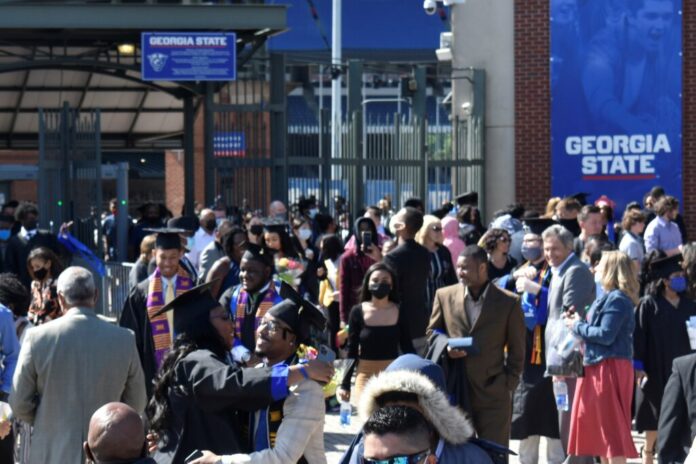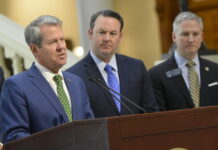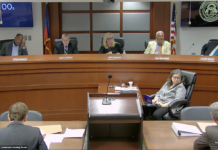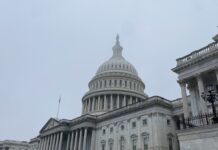
WASHINGTON (States Newsroom) — President Joe Biden on Monday will announce the rollout of a student debt forgiveness proposal that the White House believes is narrowly targeted enough to survive legal challenges.
The plan, if finalized, would include a one-time cancellation of all accrued interest for 23 million borrowers. It would also cancel the full amount of student loan debt for 4 million borrowers and provide more than 10 million borrowers with at least $5,000 in student debt relief.
The president will unveil the Department of Education proposed regulations during a speech in Madison, Wisconsin, White House press secretary Karine Jean-Pierre told reporters on a call Sunday.
The announcement comes seven months ahead of the November elections, in which student debt forgiveness remains a key issue for voters, especially younger ones. Some of those younger voters who back a ceasefire have been turned off by the administration’s support of Israel in its war against Hamas in Gaza.
The proposed rule will be released in the coming months, and the Biden administration expects some provisions, such as the interest cancellation, could be implemented as early as this fall, Jean-Pierre said.
“President Biden will use every tool available to cancel student loan debt for as many borrowers as possible, no matter how many times Republican elected officials try to stand in his way,” she said.
A fresh legal fight likely
The proposal is likely to face legal challenges, similar to the battle that engulfed Biden’s original student debt forgiveness plan. The Supreme Court struck it down last year when it was challenged in lawsuits backed by six Republican-led states — Nebraska, Missouri, Arkansas, Iowa, Kansas, and South Carolina.
Senior administration officials told reporters that the Biden administration carefully studied the Supreme Court’s opinion last year, which turned aside the administration’s argument that Education Secretary Miguel Cardona had the legal authority under the HEROES Act to enact a one-time student debt relief plan of up to $20,000 for some borrowers.
A senior administration official said the new proposals “address specific situations and specific populations in ways that we feel very confident are covered by what the secretary’s long-standing authority under (the Higher Education Act) allows him to do, and we’re confident that we’re acting within the scope of the law, as set forth by the Supreme Court.”
After the Supreme Court ruling, Biden directed the Department of Education to take a more targeted route to provide student debt relief through the Higher Education Act in anticipation of legal challenges.
“The negotiated rulemaking process is how we change and improve our higher education policies,” Cardona said to reporters Sunday, adding that the Department of Education is moving to quickly finalize the proposals.
While the rulemaking process can take months or years, Cardona has the ability to designate provisions for early implementation, a senior administration official said.
About 43.5 million people have student loan debt, totaling $1.73 trillion, according to the Federal Reserve.
Building on previous student debt relief plans
The new plan builds on several student debt relief programs the Biden administration already has rolled out, such as the Saving on a Valuable Education Plan, known as the SAVE plan, or any other income-driven repayment plans. For the SAVE plan, borrowers who make monthly payments are not charged accrued interest; payments are based on a borrower’s income and family size; and the plan forgives balances after a set number of years.
Under the proposed regulations, there would be a one-time cancellation of up to $20,000 of unpaid interest regardless of a borrower’s income level. Low-and-middle-income borrowers enrolled in any Department of Education income-driven repayment plan would be eligible to have the entire amount of their interest accrued balance canceled. Eligibility would apply to single borrowers who earn $120,000 or less and married borrowers who earn $240,000 or less.
The Biden administration estimates that 25 million borrowers would benefit from some type of interest cancellation.
“The interest forgiveness is currently crafted as a one-time benefit for example, but going forward, borrowers will benefit from substantially more favorable treatment through the SAVE program,” a senior administration official said.
The plan would also automatically cancel debt for borrowers eligible for that forgiveness under the SAVE, Public Service Loan Forgiveness or other programs like the closed school loan discharge who have not yet applied for those programs.
The Department of Education would also be able to use its own data to identify those borrowers who would be eligible for student loan debt forgiveness, but have yet to apply. The Biden administration estimates that this would cancel debt for about 2 million borrowers.
20 years of loan repayments
Under the proposed plan, borrowers who began repayment of their undergraduate student loans 20 years ago and borrowers who began repayment of their graduate loans 25 years ago would have their student loan debt canceled. Those borrowers would need to be on an income-driven repayment plan in order to qualify for that relief.
The plan also aims to cancel debt for borrowers who enrolled in low-financial-value programs, which means the total cost of attending exceeded the financial benefits.
Borrowers who attended institutions or programs that lost eligibility to participate in the federal student aid program or were denied recertification would be eligible to have their student loans canceled. And borrowers who attended those institutions that either closed or failed to provide “sufficient value” would be eligible for relief.
Cardona added that this could include some career training programs that have “taken advantage” of borrowers, or institutions that have an unusually high student loan debt default rate.
The plan would also provide relief for borrowers who are experiencing some sort of hardship in their daily lives that creates a barrier to paying back loans. Some of those financial hardships would include medical debt or child care.
While the administration is aiming for this debt relief to be immediate, a senior administration official said that some additional information would be required for the borrowers who qualify under the hardship relief.
“Our goal is for the overwhelming majority of things like interest, loans that are older, borrowers (who) attended programs that didn’t deliver financial value, to do that all automatically,” the senior administration official said.







